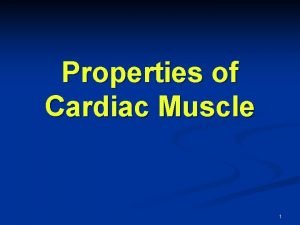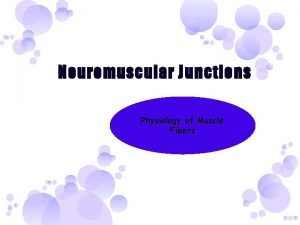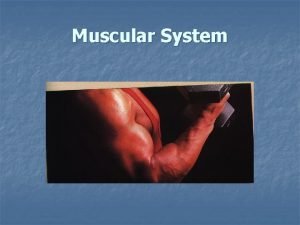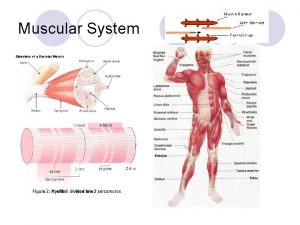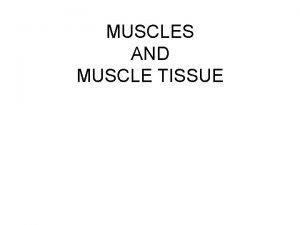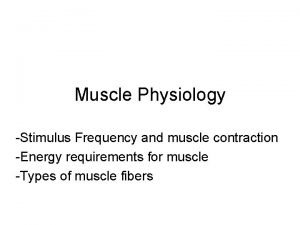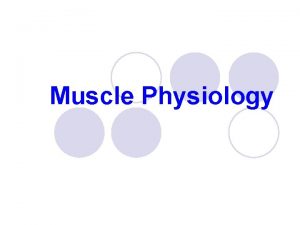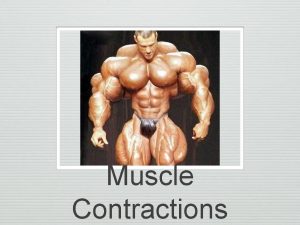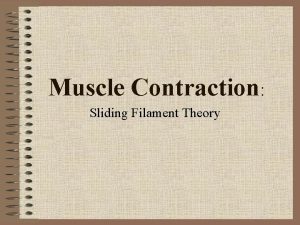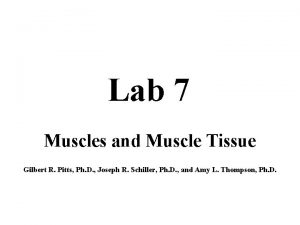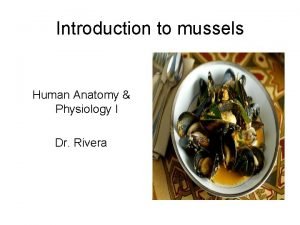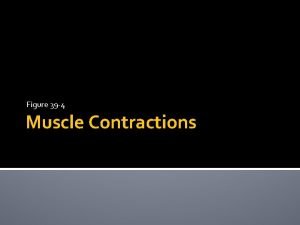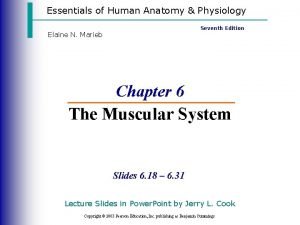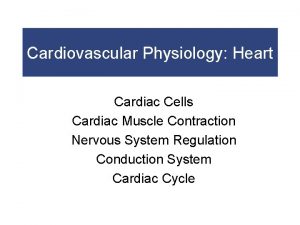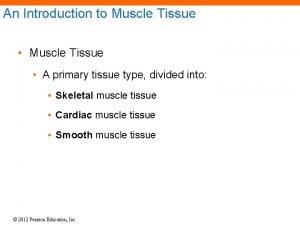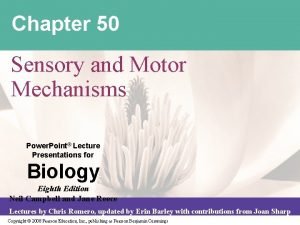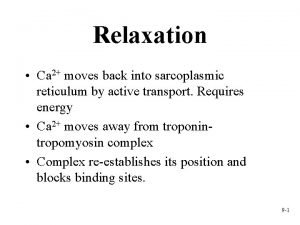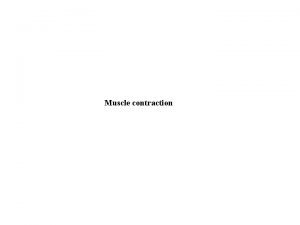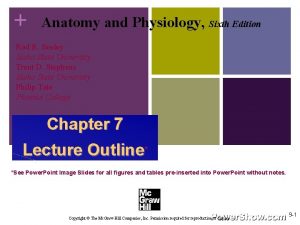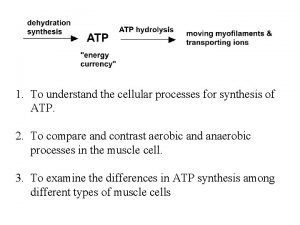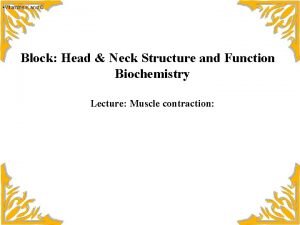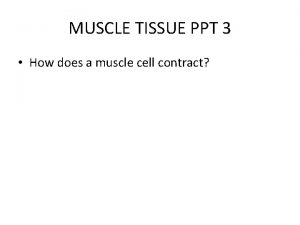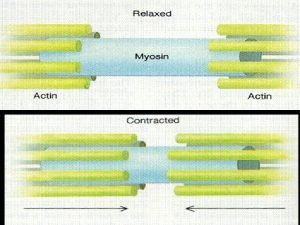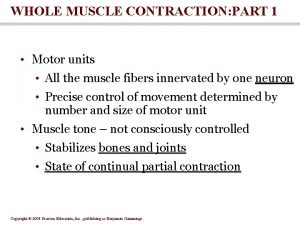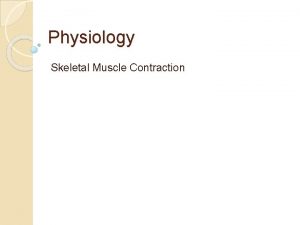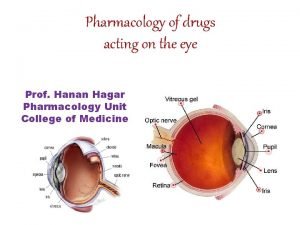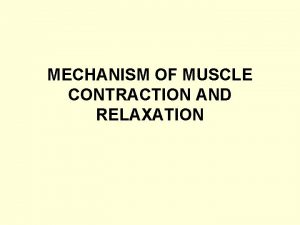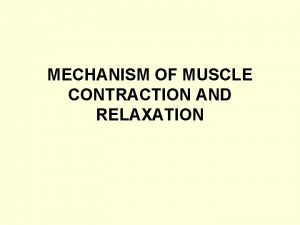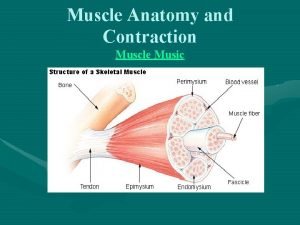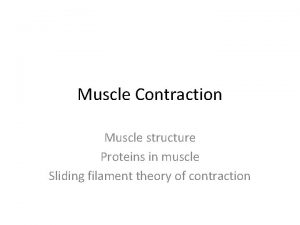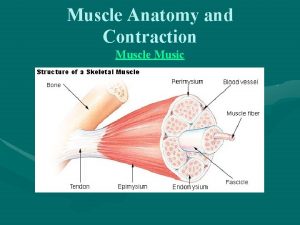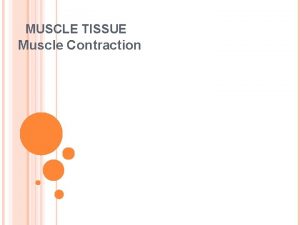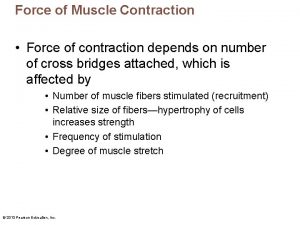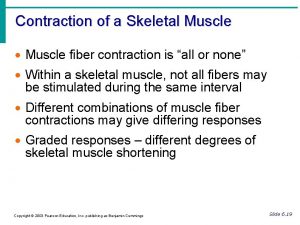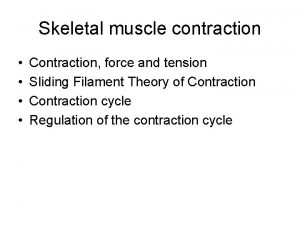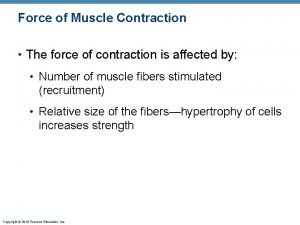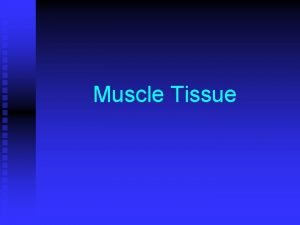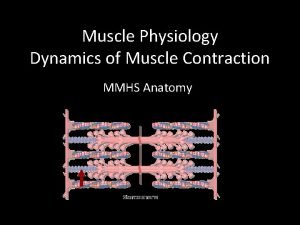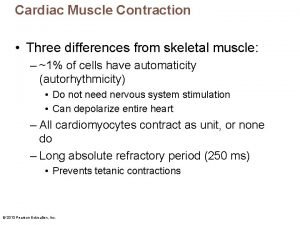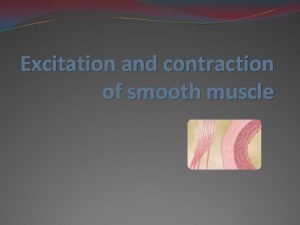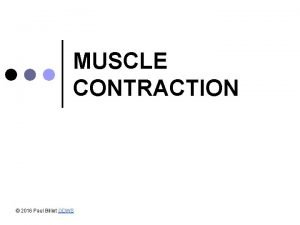Muscle Responses 1 Muscle Contraction A One method































- Slides: 31

Muscle Responses 1

Muscle Contraction A. One method of studying muscle function is to remove a single fiber and connect it to a device that records its responses to electrical stimulation. B. Threshold Stimulus 1. A muscle fiber remains unresponsive to stimulation unless the stimulus is of a certain strength, called the threshold stimulus. 2

Muscle Contraction C. All-or-None Response 1. When a muscle fiber contracts, it contracts to its full extent (all-or-none response); it cannot contract partially. 3

Muscle Contraction D. Recording a Muscular Contraction 1. A myogram is the recording of an electrically-stimulated muscle contraction. 2. A single, short contraction involving only a few motor units is referred to as a twitch. 4

Muscle Contraction 3. The time delay between when the stimulus is applied and when the muscle contracts is called the latent period, which is less than two milliseconds. 4. The latent period is followed by a period of contraction and a period of relaxation. 5

6

Type 1 Twitch Consists of red fiber SLOW-TWITCH muscles. They are slower-contracting fibers (weaker) but they are very efficient at using oxygen to create energy without lactic acid buildup. Think of these as "weaker" muscles with tons of endurance, and can go on forever. These fibers are used for high-endurance events like marathons. 7

Type 2 a Twitch These HYBRID fibers are a mix between Type I and Type II (b) fibers. They have a very high contraction rate (making them very strong and explosive), and yet very energy efficient therefore making them very resistant to fatigue. They are found infrequently in humans and are very helpful for all types of physical performance. 8

Type 2 b Twitch White muscle fibers Pure FAST-TWITCH fibers Contract very quickly (making them very strong and explosive) but they also tire out very easily. Muscle Twitch Video 9

Muscle Contraction F. Recruitment of Motor Units 1. An increase in the number of activated motor units within a muscle at higher intensities of stimulation is called recruitment. 10

Muscle Contraction G. Sustained Contractions 1. Summation and recruitment together can produce a sustained contraction of increasing strength. 2. Muscle tone is achieved by a continuous state of sustained contraction of motor units within a muscle. 11

Smooth and Cardiac Muscle Investigating other muscle types…

Smooth Muscle A. Smooth Muscle Fibers 1. Smooth muscle cells are elongated with tapered ends, lack striations and have a relatively undeveloped sarcoplasmic reticulum 13

Smooth Muscle 2. Multiunit smooth muscle and visceral muscle are two types of smooth muscles. a. In multiunit smooth muscle, such as in the blood vessels and iris of the eye, fibers occur separately rather than as sheets. 14

Smooth Muscle b. Visceral smooth muscle occurs in sheets and is found in the walls of hollow organs; these fibers can stimulate one another and display rhythmicity, and are thus responsible for peristalsis in hollow organs and tubes. USED IN DIGESTIVE SYSTEM 15

Crohn’s Disease 16

Smooth Muscle B. Smooth Muscle Contraction 1. The myosin-binding-to-actin mechanism is mostly the same for smooth muscles and skeletal muscles. 17

Cardiac Muscle A. The mechanism of contraction in cardiac muscle is essentially the same as that for skeletal and smooth muscle, but with some differences. B. Cardiac muscle has transverse tubules that supply extra calcium, and can thus contract for longer periods. Heart Surgery 18

19

Cardiac Muscle C. Complex membrane junctions, called intercalated disks, join cells and transmit the force of contraction from one cell to the next, as well as aid in the rapid transmission of impulses throughout the heart. D. Cardiac muscle is self-exciting and rhythmic, and the whole structure contracts as a unit 20

Review of Smooth and Cardiac Muscles VIDEO 21

Muscle Types and Their Actions

Skeletal Muscle Actions A. Origin and Insertion 1. The immovable end of a muscle is the origin, while the movable end is the insertion; contraction pulls the insertion toward the origin. 2. Some muscles have more than one insertion or origin. 23

24

Skeletal Muscle Actions B. Interaction of Skeletal Muscles 1. Of a group of muscles, the one doing the majority of the work is the prime mover. 2. Helper muscles are called synergists; opposing muscles are called antagonists. 25

Skeletal Muscle Actions Major Skeletal Muscles A. Muscles are named according to any of the following criteria: size, shape, location, action, number of attachments, or direction of its fibers. 26

27

28

29

30

31
 Smooth muscle cell
Smooth muscle cell Autorhythmicity definition
Autorhythmicity definition Sarcoplasmic reticulum
Sarcoplasmic reticulum 3 phases of muscle contraction
3 phases of muscle contraction Passive insufficiency of hamstrings
Passive insufficiency of hamstrings Isotonic or isometric
Isotonic or isometric Muscle spasm
Muscle spasm Incomplete tetanus muscle contraction
Incomplete tetanus muscle contraction Atp and muscle contraction
Atp and muscle contraction Sliding filament theory worksheet
Sliding filament theory worksheet Wave summation
Wave summation Isotonic contraction
Isotonic contraction Muscle contraction animation mcgraw hill
Muscle contraction animation mcgraw hill Direct phosphorylation
Direct phosphorylation Tetanus vs summation
Tetanus vs summation Cardiac cycle class 11
Cardiac cycle class 11 Motor end plates
Motor end plates 3 phases of muscle contraction
3 phases of muscle contraction Whole muscle contraction
Whole muscle contraction Phases of muscle contraction
Phases of muscle contraction Muscular contraction
Muscular contraction Phases of muscle contraction
Phases of muscle contraction Phases of muscle contraction
Phases of muscle contraction Biochemistry of muscle contraction
Biochemistry of muscle contraction Muscle tissue ppt
Muscle tissue ppt Muscle contraction
Muscle contraction Myopathy
Myopathy Physiology of muscle contraction
Physiology of muscle contraction Ciliary muscle contraction
Ciliary muscle contraction Muscle contraction
Muscle contraction One god one empire one emperor
One god one empire one emperor Little dog run
Little dog run

